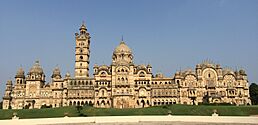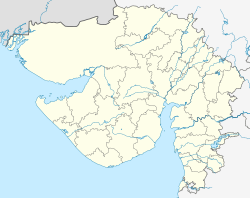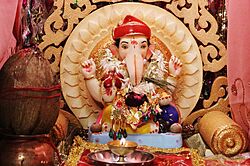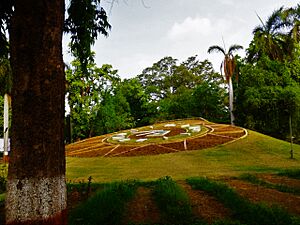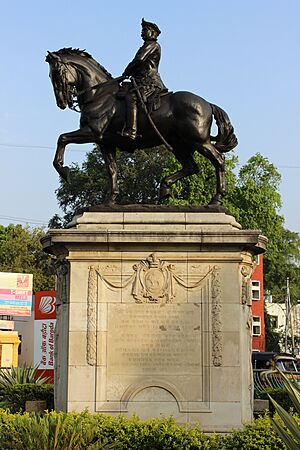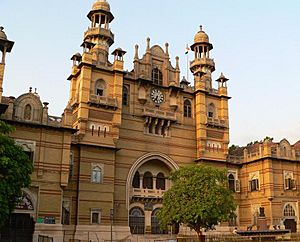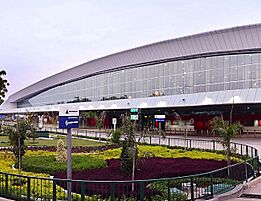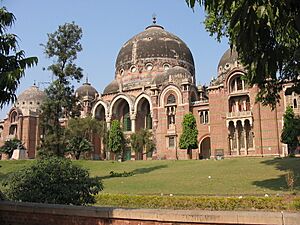Vadodara facts for kids
Quick facts for kids
Vadodara
Baroda
|
|
|---|---|
|
Clockwise from top:
Lakshmi Vilas Palace, Khanderao Market, Downtown Vadodara, Vadodara Airport, Old Vadodara District Court, Saradar Patel Planetarium, Pratap Vilas Palace |
|
| Nickname(s):
Sayaji Nagari (City of Sayajirao Gaekwad), Sanskrutik Nagari (Cultural City)
|
|
| Country | |
| State | |
| District | Vadodara |
| Government | |
| • Type | Municipal Corporation |
| • Body | Vadodara Municipal Corporation |
| Area | |
| • Metropolis | 420.33 km2 (162.29 sq mi) |
| Area rank | (3rd in Gujarat State ) |
| Elevation | 35.5 m (116.5 ft) |
| Population
(2022)
|
|
| • Metropolis | 3,100,260 |
| • Density | 7,375.78/km2 (19,103.17/sq mi) |
| • Metro | 3,100,260 |
| Demonym(s) | Barodian |
| Time zone | UTC+5:30 (IST) |
| PIN |
390 0XX
|
| Telephone code | (91)265 |
| ISO 3166 code | ISO 3166-2:IN |
| Vehicle registration | GJ-06 (Urban)/GJ-29 (Rural) |
| Literacy Rate | 94.5% |
| Legislature Strength | 76 |
| Lok Sabha constituency | Vadodara |
| Vidhan Sabha constituency | 10 |
| Climate | Tropical savanna (Köppen: Aw) |
| Planning agency | 1 (VUDA) |
| Distance from Gandhinagar | 126 kilometres (78 mi) NE (Rail & Air) |
| Distance from Mumbai | 395 kilometres (245 mi) S (Rail & Air) |
| Distance from Ahmedabad | 100 kilometres (62 mi) NW (Road) |
Vadodara (Gujarati: [ʋəˈɽodɾɑ]), also known as Baroda, is a big city in the Indian state of Gujarat. It's the main city of the Vadodara district and sits by the Vishwamitri River. The city is about 141 kilometers (88 miles) from Gandhinagar, the state capital. Important roads and railway lines connecting Delhi and Mumbai pass through Vadodara.
The city gets its name from the many banyan (vad) trees found there. People also call Vadodara the Sanskrutik Nagari (meaning 'Cultural City') and Kala Nagari (meaning 'City of Art') because of its rich culture and art.
Vadodara is famous for places like the Laxmi Vilas Palace. This grand palace was once home to the Gaekwad dynasty, a royal family from the Maratha Empire who ruled the area. The city is also home to the Maharaja Sayajirao University of Baroda, a well-known university.
Contents
- What's in a Name? The Story of Vadodara
- Vadodara's Past: A Journey Through Time
- Vadodara's Location and Weather
- People of Vadodara: Population and Languages
- Vadodara's Economy: Industries and Jobs
- Culture and Museums
- City Services: How Vadodara Works
- Getting Around Vadodara: Transport
- Sports in Vadodara
- Media and News
- Learning in Vadodara: Education
- Images for kids
- See also
What's in a Name? The Story of Vadodara
Long ago, this city was called Chandanavati, named after Raja Chandan. It was also known as Virakshetra, meaning "Land of Warriors." Later, it became Vadpatraka or Vadodará. Some say the name comes from the Sanskrit word vatodar, which means "in the belly of the banyan tree."
It's hard to know exactly when the name changes happened. European travelers and traders in the 15th century called the town Baroda, which is where that name comes from. In 1974, after India became independent, the city's official name was changed back to Vadodara.
Vadodara's Past: A Journey Through Time
Early Life: Prehistoric Times
In a place called Akota, which is now part of Vadodara, scientists have found small stone tools. These tools show that people lived here a very long time ago, even before 1000 BCE. These early people hunted and fished for food.
Ancient Times: First Thousand Years CE
By the first few centuries CE, Akota was a busy trading town. It had strong houses made of burnt bricks. Old coins and items that might be from ancient Greece or Rome have been found here. This shows that Akota traded with far-off places. It was also a big center for Jainism, a religion, and many old Jain statues have been found.
From Village to City: The Chaulukya Period
Around the 11th century, Vadodara started to become more important. It was no longer just a village but a pura, or city. Jainism also became more important in Vadodara during this time. Many old writings from this period mention Vadodara, showing it was a place where scholars worked.
Merchants from Vadodara even helped build temples in Patan, the capital city of the Chaulukya kings.
Under the Delhi Sultanate
In the 14th century, Vadodara was home to a group of Afghan leaders called the Amir-i Sadgan. They led a revolt against the ruler, Muhammad bin Tughluq, in 1344. They won some battles and took control of a large area. However, the rebellion eventually ended when the sultan offered them forgiveness.
The Gujarat Sultanate Era
Later, under the Gujarat Sultanate, Vadodara became an important city. In 1451, the city was attacked. But then, a new city called Daulatabad was built very close to the old site. This new city became the foundation for the modern Vadodara we know today.
Mughal Rule in Vadodara
After the Mughal emperor Akbar took over Gujarat in 1573, he gave Vadodara to a leader named Nawab Aurang Khan. During this time, there were some changes in how the land was managed.
In the late 1600s, groups like the Marathas and Kolis often raided Gujarat. In 1705, the Kolis attacked Vadodara and looted the city for two days.
Baroda State: A Royal Legacy
Vadodara was the capital of the Baroda State, which was ruled by the Gaekwad dynasty. This royal family played a very important role in the city's history and development.
Vadodara's Location and Weather
Where is Vadodara?
Vadodara is located in western India, about 39 meters (128 feet) above sea level. It's the 10th largest city in India, covering an area of about 400 square kilometers (154 square miles). In 2010–11, it had a population of 3.5 million people. The city is built on the banks of the Vishwamitri River. This river often dries up in the summer, leaving only a small stream. Vadodara is in a fertile area between the Mahi and Narmada Rivers. The city is in a moderate earthquake zone.
Vadodara's Climate: Seasons and Temperatures
Vadodara has a tropical savanna climate. This means it has three main seasons: summer, monsoon (rainy season), and winter. Except for the monsoon, the weather is usually dry.
- Summer: From March to July, it's very hot. The average high temperature is about 39°C (102°F), and the average low is 24°C (75°F).
- Winter: From November to February, the weather is dry and cooler. The average high is 30°C (86°F), and the average low is 15°C (59°F). Cold winds in January can make it a bit chilly.
- Monsoon: From mid-June to mid-September, the southwest monsoon brings a lot of humidity and rain. The city gets about 85 cm (33 inches) of rain on average. Sometimes, very heavy rains can cause the river to flood, like in 2005 and 2008.
The highest temperature ever recorded in Vadodara was 48.0°C (118.4°F) on May 19, 2016. The lowest was -1.1°C (30.0°F) on January 15, 1935.
| Climate data for Vadodara Airport (1991-2020, extremes 1952-present) | |||||||||||||
|---|---|---|---|---|---|---|---|---|---|---|---|---|---|
| Month | Jan | Feb | Mar | Apr | May | Jun | Jul | Aug | Sep | Oct | Nov | Dec | Year |
| Record high °C (°F) | 37.4 (99.3) |
40.6 (105.1) |
44.2 (111.6) |
45.9 (114.6) |
46.2 (115.2) |
45.6 (114.1) |
40.1 (104.2) |
39.1 (102.4) |
41.1 (106.0) |
41.4 (106.5) |
39.4 (102.9) |
37.2 (99.0) |
46.2 (115.2) |
| Mean daily maximum °C (°F) | 29.4 (84.9) |
32.1 (89.8) |
36.5 (97.7) |
39.3 (102.7) |
40.1 (104.2) |
37.3 (99.1) |
32.6 (90.7) |
31.7 (89.1) |
33.2 (91.8) |
35.8 (96.4) |
33.8 (92.8) |
30.8 (87.4) |
34.4 (93.9) |
| Mean daily minimum °C (°F) | 13.2 (55.8) |
15.4 (59.7) |
19.7 (67.5) |
24.2 (75.6) |
27.4 (81.3) |
27.6 (81.7) |
26.1 (79.0) |
25.5 (77.9) |
25.2 (77.4) |
22.7 (72.9) |
18.0 (64.4) |
14.3 (57.7) |
21.6 (70.9) |
| Record low °C (°F) | 2.8 (37.0) |
3.9 (39.0) |
9.3 (48.7) |
14.4 (57.9) |
19.4 (66.9) |
21.2 (70.2) |
22.2 (72.0) |
21.7 (71.1) |
18.1 (64.6) |
12.8 (55.0) |
6.0 (42.8) |
5.5 (41.9) |
2.8 (37.0) |
| Average rainfall mm (inches) | 4.4 (0.17) |
0.0 (0.0) |
0.1 (0.00) |
1.3 (0.05) |
3.6 (0.14) |
128.8 (5.07) |
363.7 (14.32) |
316.1 (12.44) |
163.0 (6.42) |
20.5 (0.81) |
3.7 (0.15) |
2.0 (0.08) |
1,007.1 (39.65) |
| Average rainy days | 0.3 | 0.0 | 0.0 | 0.1 | 0.2 | 4.2 | 13.8 | 12.2 | 6.8 | 1.2 | 0.3 | 0.2 | 39.4 |
| Average relative humidity (%) (at 17:30 IST) | 38 | 31 | 26 | 24 | 32 | 52 | 74 | 74 | 65 | 46 | 41 | 42 | 45 |
| Source: India Meteorological Department | |||||||||||||
Vadodara has been ranked as the 6th best "National Clean Air City" in India among large cities.
People of Vadodara: Population and Languages
In 2011, the Vadodara Municipal Corporation area had a population of 1,670,806 people. About 9.45% of the population was under 6 years old. For every 1000 males, there were 920 females. The city had a high literacy rate of 90.48%, meaning most people could read and write.
| Religions in Vadodara (2011) | ||||
|---|---|---|---|---|
| Hinduism | 85.39% | |||
| Islam | 11.20% | |||
| Jainism | 2.02% | |||
| Christianity | 0.82% | |||
| Sikhism | 0.45% | |||
| Other or not stated | 0.20% | |||
| Distribution of religions | ||||
The main religion in Vadodara is Hinduism, followed by 85.39% of the people. Islam is the second largest religion, followed by 11.20%. Other religions include Jainism (2.02%), Christianity (0.82%), and Sikhism (0.45%).
| Historical population | ||
|---|---|---|
| Year | Pop. | ±% |
| 1820 | 100,000 | — |
| 1865 | 140,000 | +40.0% |
| 1881 | 101,800 | −27.3% |
| 1891 | 116,400 | +14.3% |
| 1901 | 103,790 | −10.8% |
| 1911 | 99,345 | −4.3% |
| 1921 | 94,712 | −4.7% |
| 1931 | 112,860 | +19.2% |
| 1941 | 153,301 | +35.8% |
| 1951 | 211,407 | +37.9% |
| 1961 | 309,716 | +46.5% |
| 1968 | 400,700 | +29.4% |
| 1971 | 467,487 | +16.7% |
| 1981 | 734,473 | +57.1% |
| 1991 | 1,031,346 | +40.4% |
| 2001 | 1,338,244 | +29.8% |
| 2011 | 1,670,806 | +24.9% |
In 2011, most people in Vadodara (71.37%) spoke Gujarati as their first language. Other languages spoken include Hindi (14.83%), Marathi (7.60%), and Sindhi (1.91%).
Vadodara's Economy: Industries and Jobs
Vadodara is a big center for many industries. Large companies like Indian Oil Corporation (with its Gujarat Refinery), Gujarat State Fertilizers & Chemicals, and Reliance Industries Limited have factories nearby. Other important companies include Deepak Nitrite, Linde Engineering India, and Gujarat Alkalies and Chemicals Limited.
The city is also a major hub for making power equipment, train coaches, and defense aircraft. Many IT (information technology) companies are growing fast in Vadodara. It's also a big center for pharmaceutical industries, with many medicine companies located in and around the city.
More than 35% of India's power-transmission and distribution equipment makers are in Vadodara. About 800 smaller companies support these big players in the power and engineering industries. Larsen & Tourbo (L&T) has a "Knowledge City" here, which is a hub for several of their important businesses.
Bombardier Transportation, a company from Canada, has a factory in Savli that makes train coaches. They make coaches for the Delhi Metro and trains for Brisbane, Australia. This factory also makes train sets for the Delhi - Meerut RRTS.
Tata Advanced Systems Limited and Airbus have a joint project in Vadodara to build C-295 transport aircraft. This project will make Vadodara an important center for defense manufacturing. The first "Made in India" aircraft is expected in September 2026.
Oil and Gas Industries
Since oil and natural gas were found nearby, Vadodara has become home to many petrochemical industries. These are mostly located in the areas just outside the city.
In 1963, work started on the Gujarat Refinery near Vadodara. It began producing oil in October 1965. By 1973, it was producing 4.3 million tonnes of products each year and employed about 1,450 people.
The refinery makes products like gasoline, diesel fuel, kerosene, jet fuel, and other industrial materials. Crude oil is brought in through pipes from other parts of Gujarat.
In 1978, two new petrochemical plants started in Vadodara, making materials like polyethylene. In 1979, a large petrochemical complex was officially opened. It included an oil refinery and seven other facilities that make various chemicals used in industries.
Culture and Museums
Museums to Explore
Vadodara has some interesting museums you can visit:
- Sayaji Baug, Baroda Museum and Picture Gallery
- Maharaja Fatehsinh Museum
- Museum Of Archeology And Ancient History
- Health Museum, Sayaji Baug
City Services: How Vadodara Works
The city's services are managed by the Vadodara Municipal Corporation (VMC). They have three main departments: engineering, health, and support.
- The engineering department handles things like roads, bridges, drainage, streetlights, and managing solid waste.
- The health department takes care of public health, including waste management and birth/death registrations.
- The support department manages IT, accounts, and other administrative tasks.
City Planning and Development
Two main groups plan how Vadodara grows: the VMC and the Vadodara Urban Development Authority (VUDA). VUDA plans for the whole Vadodara area, while VMC focuses on the city itself.
Vadodara's population grew very quickly between 1961 and 1971. The first official city plan was made in 1970. In the 1970s and 80s, new housing was built on the city's edges for factory workers. Later, the focus shifted to building mixed housing areas.
Some unplanned slum areas have formed because many people moved to the city quickly. These areas often have temporary homes and poor sanitation.
Managing City Waste
The municipal corporation's health department manages solid waste in Vadodara. They are responsible for sweeping, cleaning, and dealing with complaints. Staff members work in the field every weekday morning to ensure cleanliness. There's also a system to prevent littering, and people who litter can be fined.
Water Supply for the City
Vadodara gets about 240 million liters (63 million gallons) of water every day. This water is provided by the VMC's water works department and other agencies.
One source of drinking water is the Sardar Sarovar Dam. Water also comes from the Mahi River, which is naturally filtered through sand. The Ajwa Sarovar is another source, and its water is cleaned at the Nimeta Water Purification Plant.
Drainage and Sewage Systems
The engineering department handles the city's drainage and sewage systems. They plan, design, and maintain the network of sewers, pumping stations, and sewage treatment plants.
As of 2001, about 55% of the city area had sewage coverage. The goal is to increase this to 95% of the area and 93% of the population by 2021.
Electricity for Vadodara
Madhya Gujarat Vij Company Limited (MGVCL) is the main company that provides electricity to Vadodara and the state of Gujarat. Additionally, hydroelectricity is generated from the Sardar Sarovar Dam.
Fire and Emergency Services
The VMC's fire department provides fire and rescue services. They also offer other services like providing water tankers for homes or events, and ambulances or vehicles to carry deceased persons.
Getting Around Vadodara: Transport
Vadodara is on major railway and road routes that connect Mumbai with Delhi and Mumbai with Ahmedabad.
Air Travel
Vadodara Airport (IATA: BDQ) is located northeast of the city. You can fly from Vadodara to Mumbai, New Delhi, Hyderabad, Bangalore, Pune, and Goa. Air India and IndiGo are the airlines that fly from here. A new international terminal was opened in October 2016. Vadodara is the first "Green Airport" in Gujarat and the second in India.
Train Travel
Vadodara was an important stop on the historic Bombay, Baroda and Central India Railway, which reached the city in 1861. Today, Vadodara Railway Station is a major junction on the Western Railway network of Indian Railways.
India's first High-speed rail line, the Mumbai–Ahmedabad high-speed rail corridor, will have a stop at Vadodara Junction. The station is being updated to handle this new high-speed line.
Bus Services
The Vadodara bus station is designed to look like banyan trees. It's located near the railway station and also has a market, food court, and movie theater.
Road Transport
Vadodara has taxi services, mostly found near the railway station and the Vadodara Airport. There are also private cab services like Ola and Uber. You can also rent self-drive cars from private companies.
Sports in Vadodara
Vadodara has its own professional cricket team, the Baroda cricket team. The city is home to Moti Baug, which is the oldest cricket ground in Asia. The Baroda team has won the Ranji Trophy six times. Reliance Stadium, a private cricket ground, hosts international one-day matches.
Many famous cricketers are from Baroda, including Vijay Hazare, Irfan Pathan, Yusuf Pathan, Hardik Pandya, and Krunal Pandya. A new international cricket stadium is being built in Kotambi, and a sports university will be built in Desar.
Media and News
The city has five local FM radio stations: Radio City (91.1 MHz), Radio Mirchi (98.3 MHz), Red FM (93.5 MHz), Big FM (92.7 MHz), and All India Radio, Vividh Bharti (93.9 MHz). All India Radio also broadcasts on the AM band.
Vadodara News Magazine (VNM) is a local TV news channel that covers events in the city. Sandesh News is another local news TV channel.
Learning in Vadodara: Education
Vadodara has many schools and colleges, including Baroda High School. Its higher education institutions attract students from other countries, especially from African nations like Ethiopia, Zimbabwe, and Kenya.
Universities in Vadodara
- The Maharaja Sayajirao University of Baroda
- Sigma Group of Institute
- Parul University
- Navrachna University
- GSFC University
- National Rail and Transportation Institute (Railway University)
- Sumandeep Vidyapeeth
- ITM Vocational University
- ITM (SLS) Baroda University
Secondary Schools in Vadodara
There are several private and public secondary schools in Vadodara, such as:
- Navrachana Higher Secondary School
- Navrachana Vidyani Vidyalaya
- Navrachana International School
- Cygnus World School
- Zenith High School
- Cygnus International School
- Billabong High International School
- Rosary High School
- Convent of Jesus & Mary Girls High School
- Parth School Of Science & Competition
Images for kids
See also
 In Spanish: Vadodara para niños
In Spanish: Vadodara para niños


